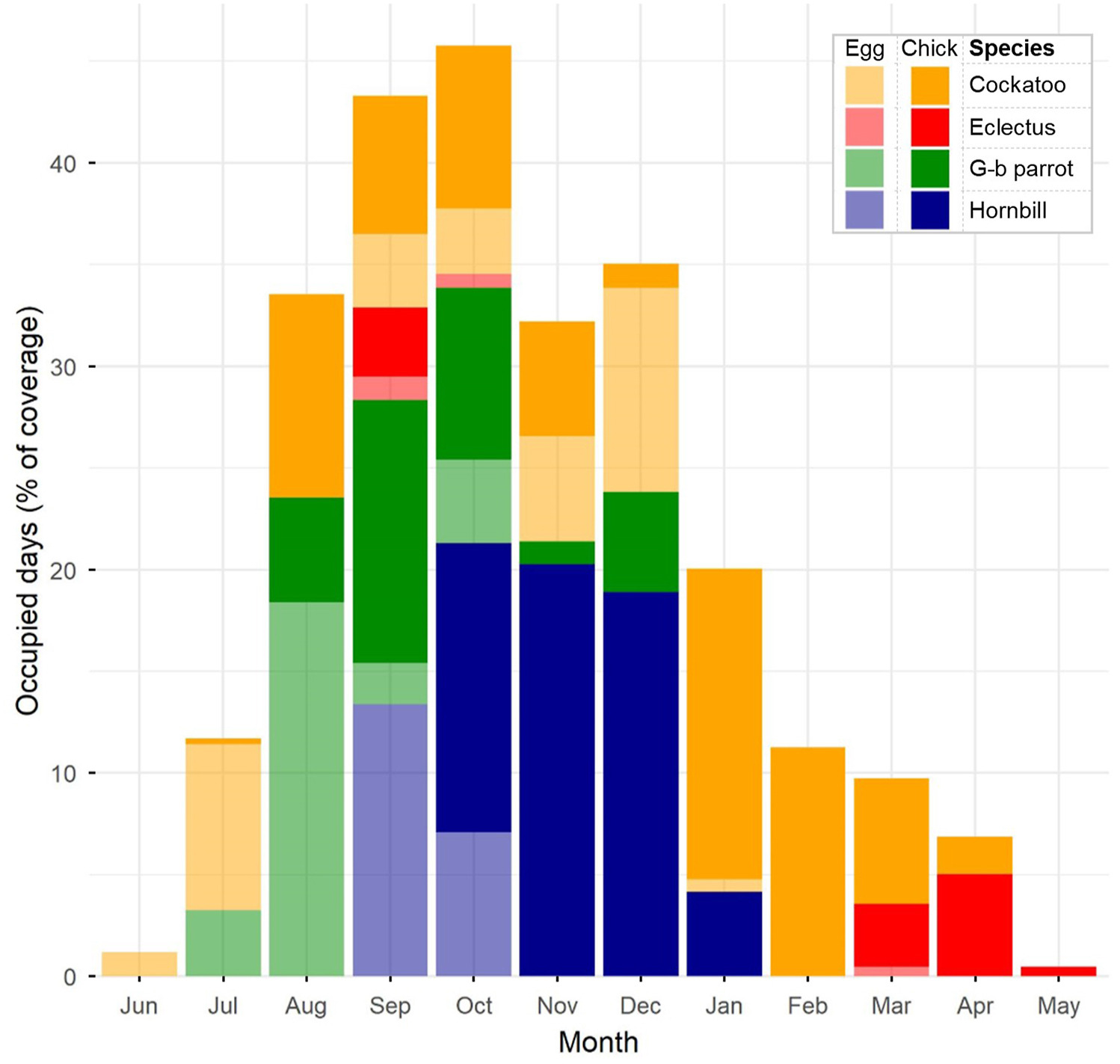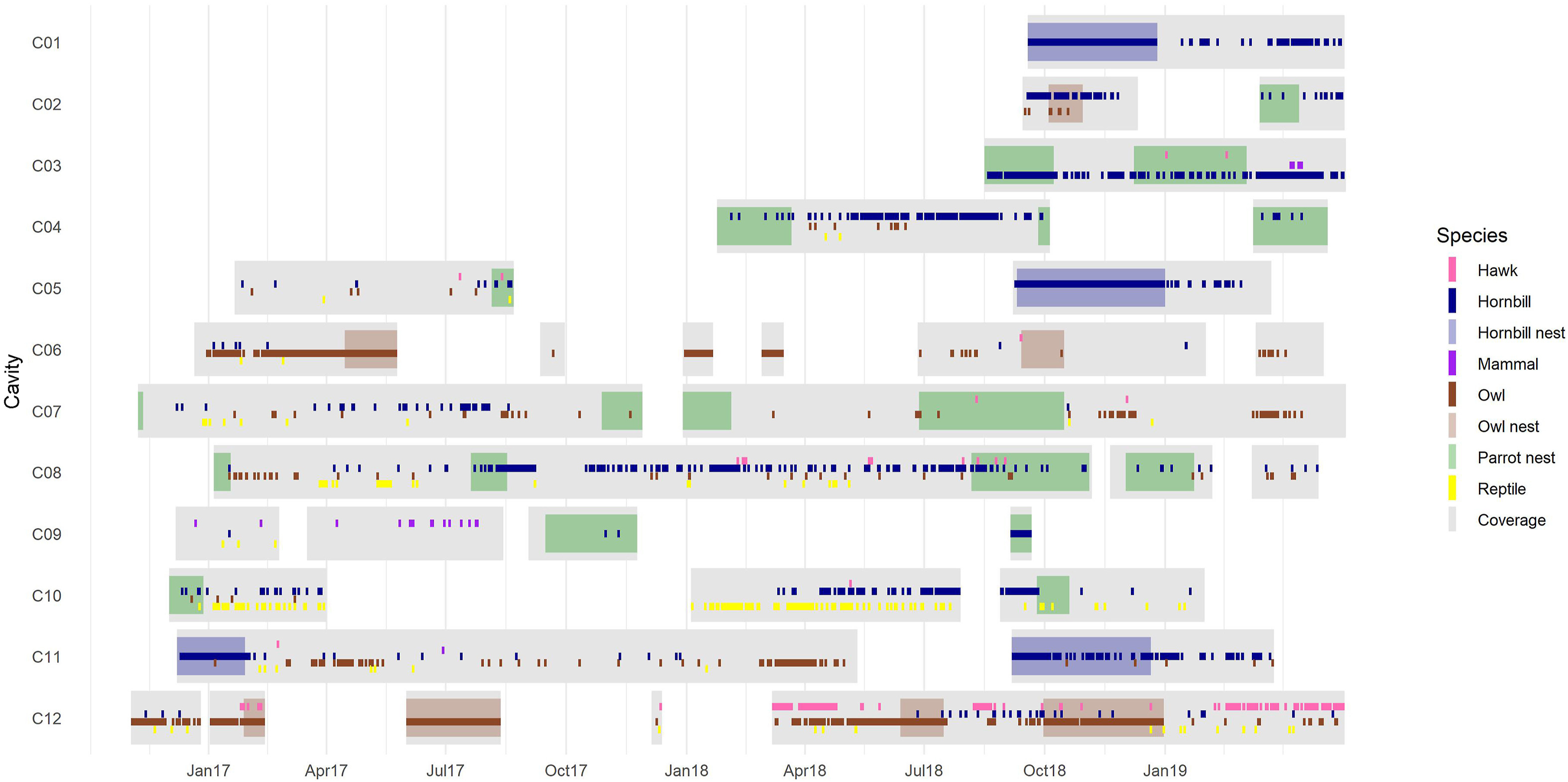
(A) Cockatoo nest tree found with traditional climbing set-up prepared for harvest by illegal trappers in 2018; (B) guide demonstrating traditional Sumba cockatoo tree-climbing method in 2017; (C) twig with nylon nooses left behind by cockatoo trappers after use at a cockatoo roost site in 2018. (Photos A,B: Charles U. Daula used with permission, C: AR).
Figures of the Article
-
![]() (A) Nest tree in deciduousforest, (B) rope access at emergent nest tree in closed-canopy forest, (C) camera set-up above nest-cavity in Tetrameles nudiflora tree occupied by a Barn Owl (Tytoalba), (D) camera-trap with brace and rain protection, (E) camera above a cavity with upwards-facing entrance. (Photos A,C: AR; B: Romy ND Limu with permission; D,E: BAS).
(A) Nest tree in deciduousforest, (B) rope access at emergent nest tree in closed-canopy forest, (C) camera set-up above nest-cavity in Tetrameles nudiflora tree occupied by a Barn Owl (Tytoalba), (D) camera-trap with brace and rain protection, (E) camera above a cavity with upwards-facing entrance. (Photos A,C: AR; B: Romy ND Limu with permission; D,E: BAS).
-
![]() (A) Cockatoo nest tree found with traditional climbing set-up prepared for harvest by illegal trappers in 2018; (B) guide demonstrating traditional Sumba cockatoo tree-climbing method in 2017; (C) twig with nylon nooses left behind by cockatoo trappers after use at a cockatoo roost site in 2018. (Photos A,B: Charles U. Daula used with permission, C: AR).
(A) Cockatoo nest tree found with traditional climbing set-up prepared for harvest by illegal trappers in 2018; (B) guide demonstrating traditional Sumba cockatoo tree-climbing method in 2017; (C) twig with nylon nooses left behind by cockatoo trappers after use at a cockatoo roost site in 2018. (Photos A,B: Charles U. Daula used with permission, C: AR).
-
![]() Seasonality of cavity-nesting monitored by camera-traps over 2.5 years (November 2016–April 2019) in the forested areas of central and western Sumba. Paler colours indicate days at egg stage, darker colours chick stage. Data were pooled across three breeding seasons and twelve cavities that had cockatoos prospecting them at some point. (For interpretation of the references to colour in this figure legend, the reader is referred to the Web version of this article.)
Seasonality of cavity-nesting monitored by camera-traps over 2.5 years (November 2016–April 2019) in the forested areas of central and western Sumba. Paler colours indicate days at egg stage, darker colours chick stage. Data were pooled across three breeding seasons and twelve cavities that had cockatoos prospecting them at some point. (For interpretation of the references to colour in this figure legend, the reader is referred to the Web version of this article.)
-
![]() Visitors and occupants of nesting cavities monitored by camera-traps over three breeding seasons, November 2016–April 2019, in the forested areas of central and western Sumba. Each row represents one of twelve cavities with cockatoo interest. Small narrow, darker bars indicate visits. Broad paler bars indicate that the respective species occupied the cavity, i.e. had either eggs or chicks within. Grey background indicates the days covered by camera footage.
Visitors and occupants of nesting cavities monitored by camera-traps over three breeding seasons, November 2016–April 2019, in the forested areas of central and western Sumba. Each row represents one of twelve cavities with cockatoo interest. Small narrow, darker bars indicate visits. Broad paler bars indicate that the respective species occupied the cavity, i.e. had either eggs or chicks within. Grey background indicates the days covered by camera footage.
-
![]() Direct evidence of competitive interaction at Citron-crested Cockatoo cavities: (A) Sumba Eclectus attempting to take over a cockatoo cavity; (B) Sumba Hornbill and Great-billed Parrot competing for a cavity used by Citron-crested Cockatoos in the previous season; (C) Sumba Hornbill displacing a cockatoo from its prospected cavity; (D) a cockatoo repeatedly evicting a Great-billed Parrot from its cavity before either laid eggs; (E) Sumba Hornbill attempting to take over an active Great-billed Parrot nest; (F) cockatoo finding a Barn Owl inside the cavity the cockatoo pair had been prospecting for weeks, while a second cavity occupied by a different cockatoo pair can be seen below bordering the top left edge of the image. (Photos: camera-traps deployed, programmed, serviced and collected by team AR, BAS, Romy ND Limu, used with permission).
Direct evidence of competitive interaction at Citron-crested Cockatoo cavities: (A) Sumba Eclectus attempting to take over a cockatoo cavity; (B) Sumba Hornbill and Great-billed Parrot competing for a cavity used by Citron-crested Cockatoos in the previous season; (C) Sumba Hornbill displacing a cockatoo from its prospected cavity; (D) a cockatoo repeatedly evicting a Great-billed Parrot from its cavity before either laid eggs; (E) Sumba Hornbill attempting to take over an active Great-billed Parrot nest; (F) cockatoo finding a Barn Owl inside the cavity the cockatoo pair had been prospecting for weeks, while a second cavity occupied by a different cockatoo pair can be seen below bordering the top left edge of the image. (Photos: camera-traps deployed, programmed, serviced and collected by team AR, BAS, Romy ND Limu, used with permission).
-
![]() Visits to nest-cavities by potential predators recorded by 12 camera-traps at cavity entrances. Grey background indicates days monitored by camera-traps; periods with active nests (with eggs or chicks) are shaded in the colour of the occupying species. Species recorded as occupants or predators include (parrots): Citron-crested Cockatoo (Cacatua citrinocristata), Sumba Eclectus (Eclectus cornelia) and Great-billed Parrot (Tanygnathus megalorynchos); (owls): Sumba Boobook (Ninox rudolfi), Least Boobook (Ninox sumbaensis) and Barn Owl (Tytoalba); (hornbill) Sumba Hornbill (Rhyticeros everetti); (hawks): Eastern Buzzard (Buteo japonicus), Brown Goshawk (Accipiter fasciatus) (and other Accipiter spp.), Spotted Kestrel (Falco moluccensis) and Australian Hobby (F. longipennis); (mammals): Long-tailed Macaque (Macacafascicularis), Common Palm Civet (Paradoxurushermaphroditus) and rats Rattus sp.; (reptiles): TokayGecko (Gecko gecko) and Emerald Tree Skink (Lamprolepis smaragdina), Lesser Sundas Bronzeback Snake (Dendrelaphis inornatus). (For interpretation of the references to colour in this figure legend, the reader is referred to the Web version of this article.)
Visits to nest-cavities by potential predators recorded by 12 camera-traps at cavity entrances. Grey background indicates days monitored by camera-traps; periods with active nests (with eggs or chicks) are shaded in the colour of the occupying species. Species recorded as occupants or predators include (parrots): Citron-crested Cockatoo (Cacatua citrinocristata), Sumba Eclectus (Eclectus cornelia) and Great-billed Parrot (Tanygnathus megalorynchos); (owls): Sumba Boobook (Ninox rudolfi), Least Boobook (Ninox sumbaensis) and Barn Owl (Tytoalba); (hornbill) Sumba Hornbill (Rhyticeros everetti); (hawks): Eastern Buzzard (Buteo japonicus), Brown Goshawk (Accipiter fasciatus) (and other Accipiter spp.), Spotted Kestrel (Falco moluccensis) and Australian Hobby (F. longipennis); (mammals): Long-tailed Macaque (Macacafascicularis), Common Palm Civet (Paradoxurushermaphroditus) and rats Rattus sp.; (reptiles): TokayGecko (Gecko gecko) and Emerald Tree Skink (Lamprolepis smaragdina), Lesser Sundas Bronzeback Snake (Dendrelaphis inornatus). (For interpretation of the references to colour in this figure legend, the reader is referred to the Web version of this article.)
Related articles
-
2024, 15(1): 100155. DOI: 10.1016/j.avrs.2023.100155
-
2023, 14(1): 100121. DOI: 10.1016/j.avrs.2023.100121
-
2022, 13(1): 100044. DOI: 10.1016/j.avrs.2022.100044
-
2022, 13(1): 100036. DOI: 10.1016/j.avrs.2022.100036
-
2021, 12(1): 58. DOI: 10.1186/s40657-021-00294-1
-
2020, 11(1): 28. DOI: 10.1186/s40657-020-00214-9
-
2018, 9(1): 42. DOI: 10.1186/s40657-018-0135-4
-
2015, 6(1): 2. DOI: 10.1186/s40657-015-0012-3
-
2015, 6(1): 14. DOI: 10.1186/s40657-015-0023-0
-
2010, 1(2): 97-111. DOI: 10.5122/cbirds.2010.0001


 Download:
Download:










 Email Alerts
Email Alerts RSS Feeds
RSS Feeds